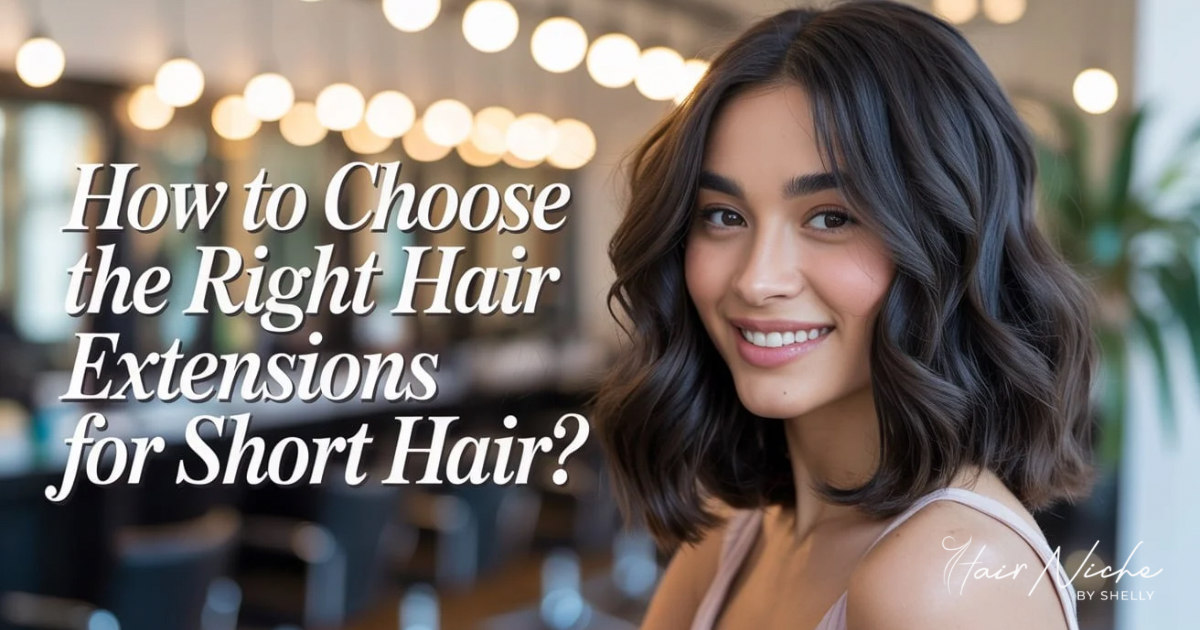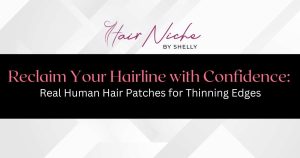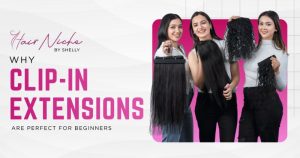
How To Choose The Right Hair Extensions For Short Hair
Hair extensions aren’t just for long-haired beauties. In fact, they can be a total game-changer for those with short hair—whether you’re growing out a pixie cut, recovering from a bad haircut, or simply craving longer, fuller locks. The key lies in choosing the right type of extensions that blend seamlessly, look natural, and complement your hair type and lifestyle.
If you’re wondering, “Can I even wear hair extensions with my short hair?”—the answer is a resounding YES! You just need the right knowledge, the right technique, and a bit of styling savvy.
In this blog, we’ll walk you through everything you need to know:
- Which hair extensions work best for short hair
- How to make extensions look natural
- Tips for blending, styling, and choosing the right length
- Mistakes to avoid when using extensions on short hair
Let’s dive in!
Why Consider Hair Extensions For Short Hair?
Short hair can be fierce, bold, and beautiful—but it also comes with limitations when it comes to styling versatility. Hair extensions offer several benefits:
- Instant Length & Volume: No more waiting months for your hair to grow.
- Style Freedom: Buns, braids, waves, and ponytails become possible.
- Color Without Commitment: Add highlights or lowlights without bleaching.
- Confidence Boost: Whether it’s a special occasion or daily glam, extensions enhance your look and mood.
However, blending extensions into short hair (especially above the shoulder) requires more planning than it does with long layers. Let’s explore how to make the magic happen.
Factors To Consider Before Choosing Short Hair Extensions For Women
Before you purchase or apply extensions, think about the following:
1. Current Hair Length: If your hair is extremely short (e.g., pixie cut), you may need to wait until it reaches at least 3–4 inches to ensure the extensions have something to grip onto. If your hair is chin-length or longer, you have more flexibility.
2. Hair Thickness: Short and thick? You’ll need more wefts to blend. Short and fine? Lightweight options work better. The thicker the contrast between your natural hair and the extension length, the more blending you’ll need.
3. Hair Texture: Match the texture (straight, wavy, curly, coily) for seamless results. Human hair extensions are ideal because they can be styled to match your texture.
4. Color Matching: Choose a color that matches your ends—not your roots. This ensures a natural look when the extensions are added. For a multidimensional look, consider balayage or ombré extensions.
5. Budget: From clip-ins to permanent bonds, prices vary greatly. Clip-ins and halo extensions are usually more affordable, while semi-permanent options like keratin bonds cost more but offer longer wear.
Best Hair Extensions For Short Hair
Let’s go over the top types of extensions and evaluate their suitability for short hair.
1. Clip-In Hair Extensions
Best for: Temporary transformations, special occasions, beginners
Clip-ins are wefts of hair that attach to your natural hair with small clips. For short hair, use multiple wefts in layers to hide the natural short layers underneath.
Pros:
- Easy to apply and remove
- No salon needed
- Budget-friendly
Cons:
- Can feel bulky if hair is very short
- May show if not blended properly
Pro Tip: Add two to three wefts at the nape and middle section to hide blunt ends.
2. Tape-In Hair Extensions
Best for: A semi-permanent, natural look
These extensions are taped between sections of your natural hair. They lie flat and are excellent for blending with short, fine hair.
Pros:
- Lightweight and discreet
- Reusable with proper care
- Looks very natural when installed professionally
Cons:
- Requires a salon visit
- Needs maintenance every 6–8 weeks
- Not great for very oily scalps
Pro Tip: Ask your stylist to layer the extensions for a more natural fall with short hair.
3. Halo Extensions (Wire Extensions)
Best for: Instant volume with zero damage
A halo extension is a single weft attached to a thin, invisible wire that sits on your crown. Great for shoulder-length or bob cuts.
Pros:
- No clips, glue, or damage
- Comfortable and easy to apply
- Great for sensitive scalps
Cons:
- Not suitable for super short or pixie cuts
- May shift if not fitted properly
Pro Tip: Tease the crown slightly and use hairspray for better grip.
4. Micro-Link Or I-Tip Extensions
Best for: Long-term use with less damage
Strand-by-strand extensions that are clamped using micro beads. Suitable for hair that’s at least 4–5 inches long.
Pros:
- No heat or glue
- Long-lasting (up to 3 months)
- Natural movement
Cons:
- Requires professional installation
- Can be visible in short hair without proper sectioning
5. Keratin Bond (Fusion) Extension
Best for: A seamless, long-term transformation
These are individual strands bonded to your hair with keratin and heat. Ideal for people with short hair who want a full transformation.
Pros:
- Extremely natural-looking
- Stays in place for months
- Blends well with short hair when applied strategically
Cons:
- Expensive
- Time-consuming to install
- Must be removed professionally
Pro Tip: Request shorter strands near the top and longer ones at the bottom for a tapered look.
6. Hair Toppers And Patch
Best for: Short hair with thinning at the crown or part line
These clip-on pieces are used to add volume or coverage, not necessarily length. Perfect for women with hair thinning, postpartum hair loss, or frontal patches.
Pros:
- Lightweight and targeted coverage
- Blends naturally with short hair
- Easy to apply daily
Cons:
- Doesn’t add full head length
- Must be color-matched carefully
Tips for Blending Extensions With Short Hair
The biggest challenge with short hair is making sure your natural hair doesn’t peek through or clash. Here’s how to fix that:
1. Layer and Stack Strategically: Place shorter wefts at the nape and longer ones toward the bottom. Stack multiple wefts in one section if needed to mask blunt edges.
2. Curl or Wave Your Hair: Curling the extensions with your natural hair helps blend the textures, especially if your short hair has a harsh line.
3. Use a Blending Tool: Use a flat iron or hot tool to smooth the joint where your hair meets the extension.
4. Tease Your Roots: This creates grip for clip-ins and helps cover the base of the extensions.
5. Trim the Extensions: Ask your stylist to cut and layer the extensions after application. Customizing the length and shape is key to a natural finish.
Styling Ideas For Short Hair With Extensions
Once installed and blended, your styling options open up! Try these:
- Messy ponytail with clip-ins
- Low romantic bun using tape-ins
- Voluminous blowout with halo extensions
- Half-up half-down styles
- Braids and twists with curled ends
Just remember to use heat-protectant spray and avoid tugging when brushing.
Short Hair Extensions for Special Occasions
- Weddings: Pixie or bob with halo or clip-ins for soft, romantic curls.
- Birthday Parties: Tape-in extensions for added length and playful waves.
- Photoshoots: Keratin bonds for polished, professional looks.
- Festivals & Events: Layered clip-ins to experiment with bold colors without dyeing natural hair.
Pro Tip: Accessories like pins, clips, and headbands can further blend extensions and elevate your style.
Common Mistakes To Avoid
1. Buying too long extensions: For short hair, don’t jump straight to 24-inch wefts. Start with 14–18 inches to avoid the “mullet” effect.
2. Skipping the stylist: Professional installation can make or break the look. DIY can be risky, especially with semi-permanent methods.
3. Using low-quality synthetic hair: Cheap fibers don’t blend well and can’t be styled like human hair.
4. Ignoring maintenance: Brush gently, avoid sleeping in wet extensions, and keep them tangle-free.
Maintenance Tips for Short Hair Extensions
- Wash weekly with sulfate-free shampoo
- Avoid sleeping with clip-ins to prevent tangling
- Use heat protectants before curling or straightening
- Detangle gently with a soft-bristle brush
- Follow stylist instructions for tape-ins, micro-links, or keratin bonds
- Store extensions in a cool, dry place when not in use
Final Thoughts: Embrace the Power of Transformation
Choosing the right hair extensions for short hair isn’t just about adding inches—it’s about expressing yourself, boosting your confidence, and having fun with your style. With the right type, proper application, and good aftercare, you can go from a cropped cut to voluminous locks in minutes.
No matter your hair goal—length, volume, or coverage—there’s a solution that fits.
Need help choosing the perfect extensions for your short hair?
Explore custom hair solutions like parting toppers, bangs, streaks, volumizers & more at www.hairniche.in—curated by women who understand your hair journey.
Frequently Asked Questions (FAQs)
Q1: How short is too short for extensions?
A: Hair under 3 inches may not hold extensions well.
Q2: Can I dye hair extensions to match my color?
A: Yes, only with human hair extensions. Professional advice recommended.
Q3: Will people notice my extensions?
A: Not if applied, matched, and blended properly.
Q4: Are extensions safe for thinning hair?
A: Yes, opt for clip-ins or halo extensions to avoid stress.
Q5: How often should tape-in extensions be maintained?
A: Every 6–8 weeks for best results.
Q6: Can I sleep with clip-ins?
A: Remove them before sleeping to avoid tangling.
Q7: What’s the best extension for pixie cuts?
A: Clip-ins or tape-ins in layered wefts work best.
Q8: How can I make short hair look longer instantly?
A: Use halo or clip-in extensions and style with waves or curls.
Q9: Can I swim with extensions?
A: Avoid prolonged chlorine exposure; use protective hairstyles.
Q10: Can extensions damage short hair?
A: Only if improper installation or heavy extensions are used; always follow stylist guidance.



